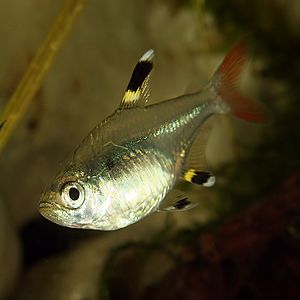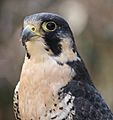Chordate facts for kids
Quick facts for kids ChordatesTemporal range: Late Ediacaran – Present
|
|
|---|---|
 |
|
| A X-ray tetra is one of the few chordates with a visible backbone | |
| Scientific classification | |
| Domain: | |
| Kingdom: | |
| Subkingdom: | |
| Superphylum: | |
| Phylum: |
Chordata
Bateson, 1885
|
| Typical Classes | |
|
See below |
|
Chordates are a big group of animals that share some special features. The most important one is having a notochord at some point in their lives. A notochord is like a flexible rod that supports the body.
This group includes all vertebrates, which are animals with a backbone, like fish, birds, mammals, and humans! It also includes some animals without backbones, called invertebrates, that are closely related.
Contents
What Makes a Chordate?
All chordates share four main features at some stage of their lives. These features might be present only when they are young, or they might stay for their whole lives.
The Notochord
The notochord is a flexible, rod-shaped structure. It runs along the back of the animal. In many chordates, like humans, the notochord develops into the backbone (or vertebral column). This backbone protects the spinal cord.
Dorsal Hollow Nerve Cord
Chordates have a nerve cord that runs along their back, above the notochord. It is hollow and forms the central nervous system. In vertebrates, this develops into the brain and spinal cord.
Pharyngeal Slits
These are openings in the throat area, behind the mouth. In fish, these slits become gills for breathing underwater. In land animals, they are only present during early development and then disappear.
Post-Anal Tail
This is a tail that extends beyond the anus. Many animals use their tail for movement, like fish swimming or monkeys swinging. In humans, the tailbone (coccyx) is a small reminder of this feature.
Types of Chordates
The Chordata group is divided into three main subphyla. Two of these are invertebrates, and one includes all the vertebrates.
Tunicates
Tunicates are also known as sea squirts. Most adult tunicates live attached to rocks or other surfaces in the ocean. They filter food from the water. Even though they look simple as adults, their young forms (larvae) have all four chordate features!
Lancelets
Lancelets are small, fish-like animals that live in shallow ocean waters. They are filter feeders and spend most of their time buried in the sand. They keep all four chordate features throughout their lives.
Vertebrates
Vertebrates are the largest and most diverse group of chordates. They are special because their notochord develops into a strong, bony or cartilaginous backbone. This backbone protects their spinal cord and helps support their body.
Jawless Fish
These are the most ancient vertebrates. They do not have jaws. Modern examples include hagfish and lampreys.
Jawed Vertebrates
This group includes all vertebrates that have jaws. Jaws allowed animals to grab and chew food, which was a huge step in evolution!
- Cartilaginous fish like sharks and rays have skeletons made of cartilage, not bone.
- Bony fish are the most common type of fish, with skeletons made of bone. This group includes almost all the fish you know, from tiny goldfish to giant tuna.
- Tetrapods are vertebrates with four limbs. This group includes:
- Amphibians (like frogs and salamanders)
- Reptiles (like snakes, lizards, and crocodiles)
- Birds
- Mammals (like dogs, cats, and humans!)
How Chordates Evolved
Scientists use phylogeny to understand how different groups of animals are related and how they evolved over millions of years. It's like building a family tree for all living things!
The diagram below shows the likely evolutionary relationships within chordates. Lines connect groups that share a common ancestor. Groups marked with a "†" are extinct, meaning they have completely died out.
| Chordata |
|
||||||||||||||||||||||||||||||||||||||||||||||||||||||||||||||||||||||||||||||||||||||||||
Where Did Chordates Come From?
Scientists believe that chordates might have evolved from the larvae of sea squirts (tunicates). Even though adult sea squirts stay in one place, their larvae can swim around. These larvae have some features that look like early vertebrates.
One idea is that these larvae started to keep their young features into adulthood. This process is called paedomorphosis. Genetic studies show that tunicates are the closest living relatives to vertebrates.
Images for kids
-
The glass catfish (Kryptopterus vitreolus) is one of the few chordates with a visible backbone. The spinal cord is housed within its backbone.
-
Cephalochordate: Lancelet
-
Craniate: Hagfish
-
Haikouichthys, from about 518 million years ago in China, may be the earliest known fish.
-
A skeleton of the blue whale, the largest animal, extant or extinct, ever discovered, outside the Long Marine Laboratory at the University of California, Santa Cruz. The largest blue whale ever reliably recorded measured 98ft (29.9m) long.
-
A peregrine falcon, the world's fastest animal. Peregrines utilise gravity and aerodynamics to achieve their top speed of around 242mph (389km/h), as opposed to locomotion.
-
A red knob sea star, Protoreaster linckii is an example of Asterozoan Echinoderm.
See also
 In Spanish: Chordata para niños
In Spanish: Chordata para niños









